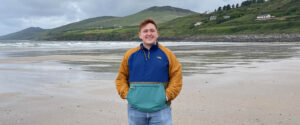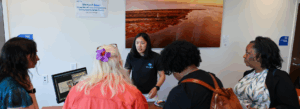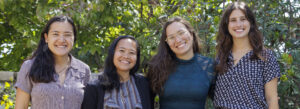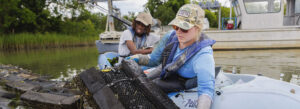National Ocean Sciences Bowl adapts to first-ever virtual competition
Just like every other spring for the past 22 years, high schoolers from across the United States competed in the National Ocean Sciences Bowl in April. But this year, instead of “keeping calm and buzzing in” while competing with other high schoolers from across the United States, team members buzzed in to answer questions by typing “b” on their keyboards during the first-ever virtual NOSB competition.
“It was clear that if we wanted to have finals this year, virtual was really the only way we were going to get it done,” NOSB Director Kristen Yarincik said.
With some adjustments and flexibility, 19 teams who won regional ocean science competitions were able to participate in the 23rd National Ocean Sciences Bowl. This year’s competition featured biology, chemistry, geology, physics, and policy questions related to the theme of “understanding human, economic, and environmental resiliency in the Gulf of Mexico.”
To accommodate teams across time zones, each team responded individually to the same set of questions, and the teams who earned the most points advanced to final rounds. Volunteer scorekeepers, judges, and moderators ran the competition rounds virtually through Zoom rooms. Even during the virtual competition, Blue Crab Bowl coordinator Carol Hopper-Brill, who volunteered as a science judge during the national competition, said volunteers and students alike were “still on the edge of our seats.”
“In the end, I would say it was far more engaging than I expected it to be,” Hopper-Brill, a marine education specialist with the Virginia Institute of Marine Science Marine Advisory Program and Virginia Sea Grant extension agent, said. “I think everybody by now has been enough in on enough Zoom meetings to feel it sometimes can be kind of dry. And this this wasn’t that at all.”
In addition to the buzzer competition, students also participated in a “Scientific Expert Briefing” where students review a piece of assigned legislation. This year, the students reviewed the Marine Oil Spill Prevention Act. Each team submits written recommendations on the legislation to the judges, and during NOSB finals, students answer questions about the legislation from different stakeholders’ perspectives.
But the National Ocean Sciences Bowl isn’t just about the competition. Students also participate in field trips and learn from ocean science professionals about the variety of career paths available.
Although this year’s competition was virtual, students still participated in question and answer sessions with ocean science professionals and went on a virtual field trip with marine scientist and author Ellen Prager, who shared her experiences on the Galapagos Islands through photos. Students interacted with each other through chat rooms during the opening ceremony and between events.
“In the end, I would say it was far more engaging than I expected it to be,” Hopper-Brill said.
“Everybody was supportive of one another, inviting people to their other social media groups and stuff like that.”
“We all sort of felt like the interactions that they were creating with each other were almost as robust as they would have been in person—they were really friendly,” Yarincik said. “Everybody was supportive of one another, inviting people to their other social media groups and stuff like that.”
The virtual competition also provided some unexpected opportunities—like during the keynote address from Craig McLean, the acting Chief Scientist for the National Oceanic and Atmospheric Administration. From his basement, McLean shared his maritime artifacts collected throughout his career in ocean exploration and the NOAA Corps.
The NOSB team, event sponsors, and what Hopper-Brill describes as an “extended family” of longtime event volunteers were able to make the first-ever virtual competition a success.
“I would thank the teams and coaches because they were so flexible, and for their willingness to undertake this experiment with us in a time where there’s just so much going on,” Yarincik said.
Takeaways:
- For the first time in 23 years, the National Ocean Sciences Bowl was held virtually.
- The virtual competition was as close to in-person as possible, with virtual field trips, keynote presentations, and a few rule modifications.
- The NOSB coordinators attributed the success of the first virtual event to the adaptability of the students, coaches, volunteers, and sponsors.
Photos and video by Aileen Devlin | Virginia Sea Grant
Story by Madeleine Jepsen | Virginia Sea Grant
Published May 22, 2020.
“I would thank the teams and coaches because they were so flexible, and for their willingness to undertake this experiment with us in a time where, you know, there’s just so much going on,” Yarincik said.





